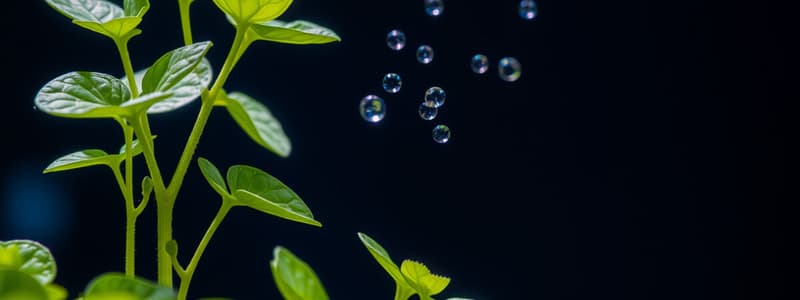Podcast
Questions and Answers
What is photosynthesis?
What is photosynthesis?
The process by which plants and some other organisms use light energy to convert water and carbon dioxide into oxygen and high-energy carbohydrates such as glucose.
What is chlorophyll?
What is chlorophyll?
A green pigment found in the chloroplasts of plants, algae, and some bacteria that absorbs light energy to carry out photosynthesis.
What is cellular respiration?
What is cellular respiration?
A process used by many organisms to break down food molecules in the presence of oxygen to create energy known as ATP.
How is energy defined in biological terms?
How is energy defined in biological terms?
What is matter?
What is matter?
What does the Law of Conservation of Energy state?
What does the Law of Conservation of Energy state?
What is the Law of Conservation of Mass?
What is the Law of Conservation of Mass?
What is an energy pyramid?
What is an energy pyramid?
What is the carbon cycle?
What is the carbon cycle?
Flashcards are hidden until you start studying
Study Notes
Photosynthesis
- Plants and some organisms utilize light energy to transform water and carbon dioxide into oxygen and carbohydrates like glucose.
Chlorophyll
- This green pigment is crucial for photosynthesis, located in the chloroplasts of plants, algae, and some bacteria, as it absorbs light energy.
Cellular Respiration
- Organisms perform this process to decompose food molecules with oxygen, resulting in the production of ATP (adenosine triphosphate), an essential energy carrier.
Energy
- Defined as the ability to perform work, especially in biological contexts, where it causes changes in systems or organisms.
Matter
- Refers to anything that possesses mass and occupies physical space, forming the basis of all physical substances.
The Law of Conservation of Energy
- Energy cannot be created or annihilated, but it can be transformed from one form to another, maintaining a constant total energy amount in a closed system.
The Law of Conservation of Mass
- In chemical reactions, mass remains constant; the initial mass of elements equals the mass of those elements after the reaction concludes.
Energy Pyramid
- A graphical representation illustrating the energy transfer across trophic levels in an ecosystem, showing the diminishing energy available as one moves from producers to apex consumers.
Carbon Cycle
- Describes the cyclical movement of carbon between living organisms and the nonliving environment, facilitating the organic circulation of carbon in nature, from the atmosphere into organisms and back.
Studying That Suits You
Use AI to generate personalized quizzes and flashcards to suit your learning preferences.




